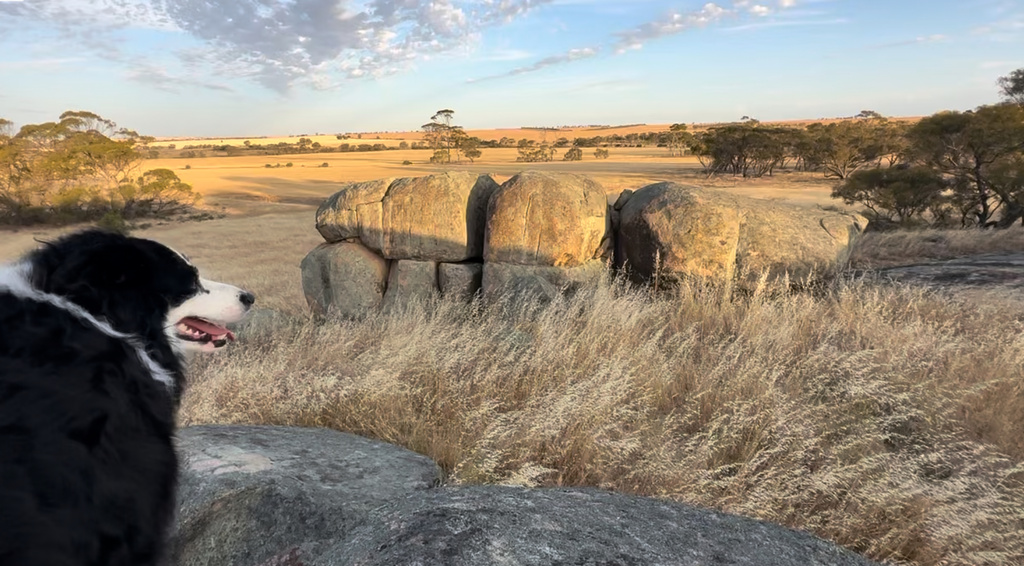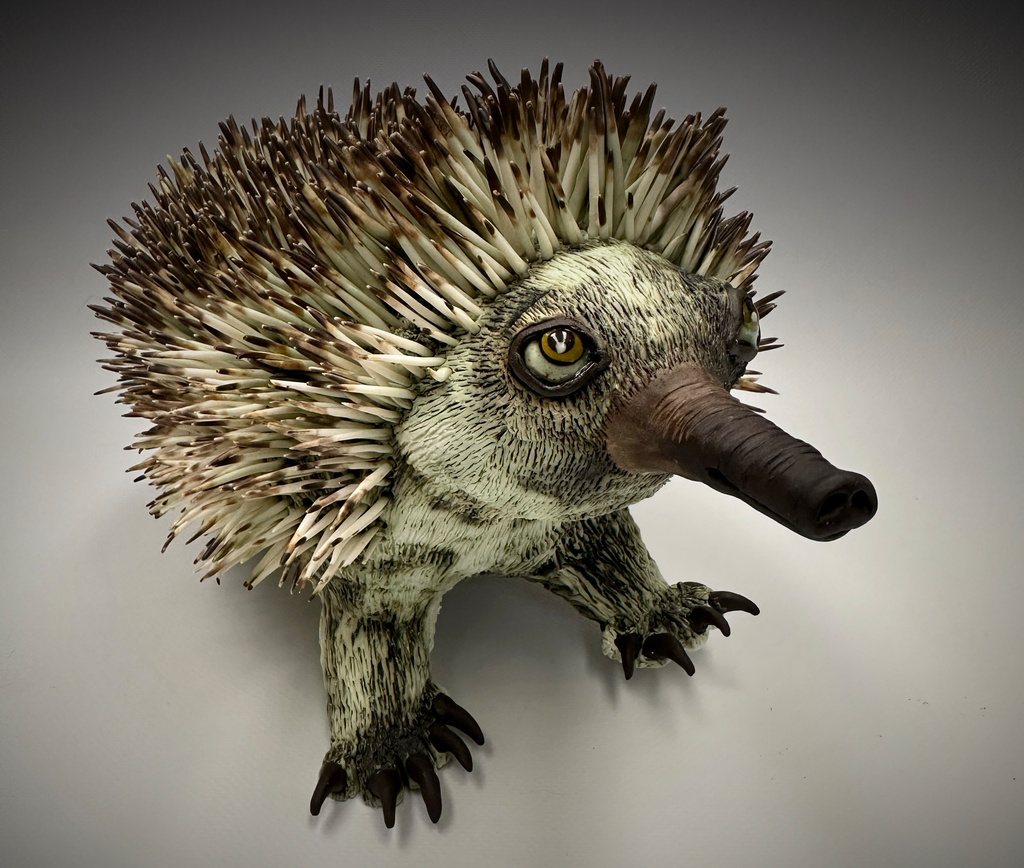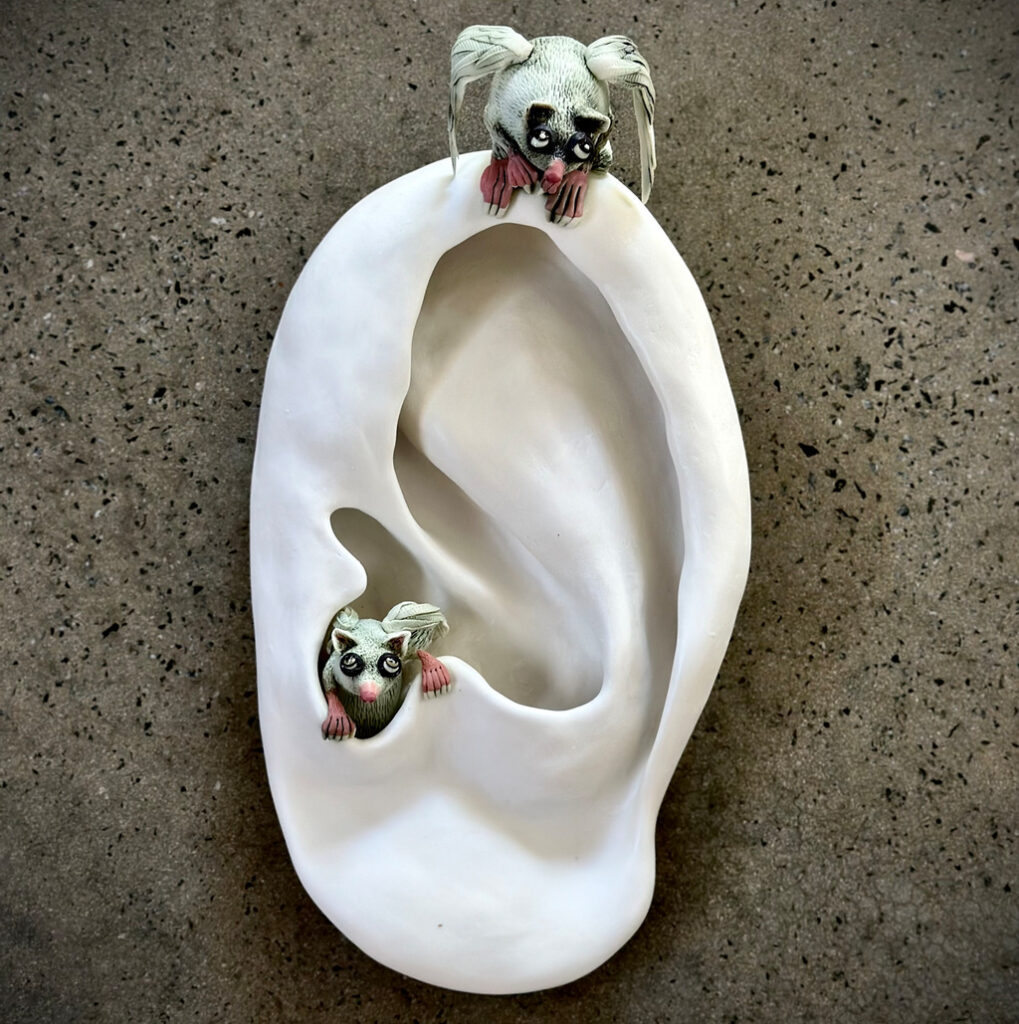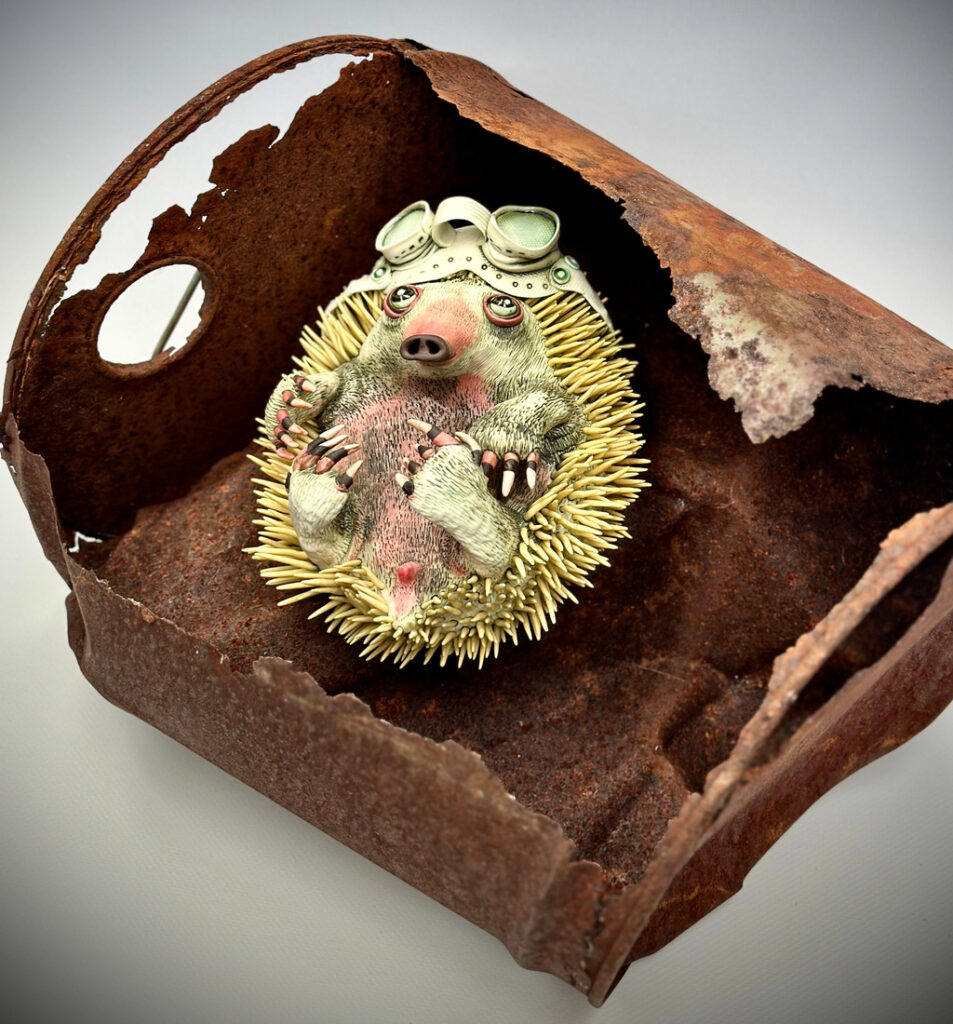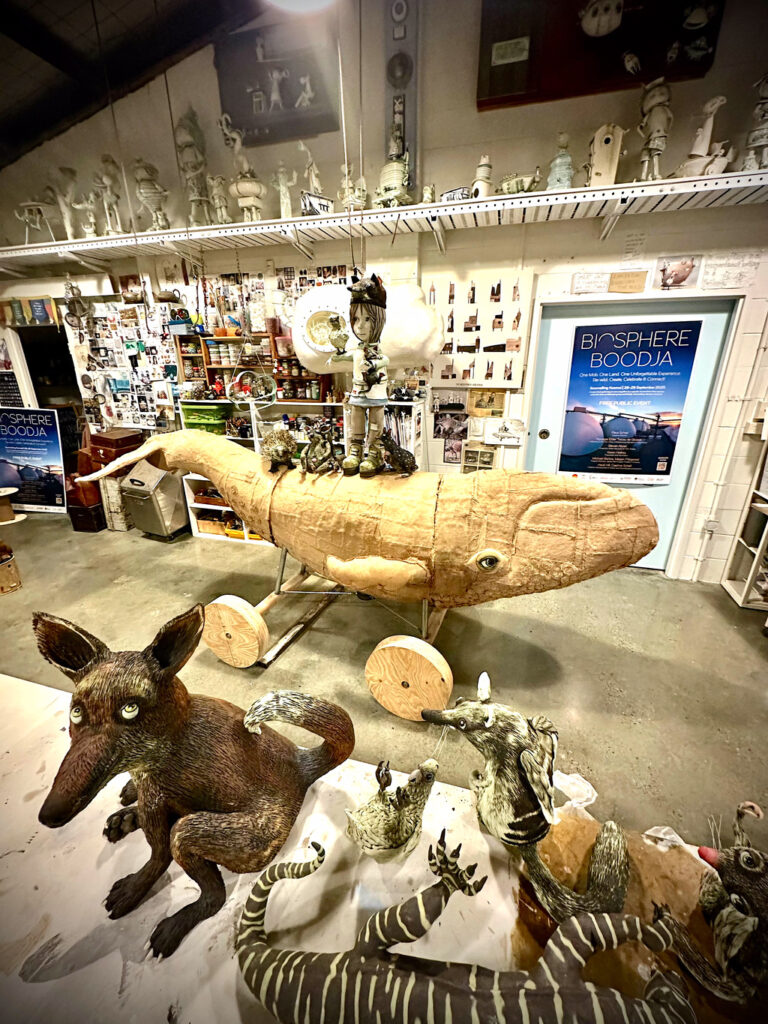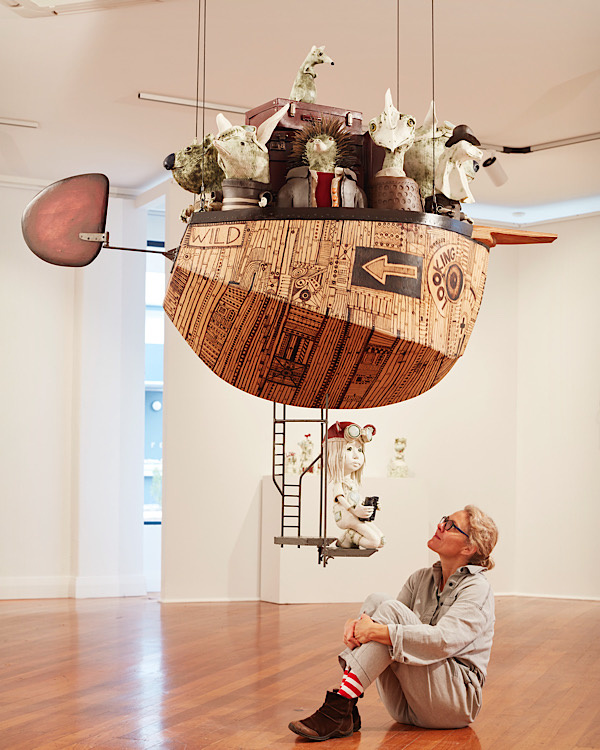Vanessa Gould tells of Fleur Schell’s journey from childhood enchantment to shared appreciation of Country with Aunty Tracey de Grussa.
A farmyard tip might not seem like the most poetic place for an epiphany, but West Australian ceramicist Fleur Schell knows how to grab inspiration wherever it hits.
Five generations of family detritus reveals itself in layers of dirt on her family farm near the wheatbelt farm of Goomalling on the edge of WA’s Avon Valley. At the deepest layer, there is heavy sheet metal, probably welded by a long-gone predecessor. Then come the lighter commercial pieces of metal, then the plastic precursor Bakelite, then, closest to the surface, the most common artefacts of the modern age, plastic.
- Fleur Schell – Nyingarn (echidna) Fleur Schell 2024 L36cm x H20cm x W26cm Porcelain
- Fleur Schell – Listen Fleur Schell 2024 H 45cm x W25cm D12cm Porcelain
- Fleur Schell – Home for Nyingarn (echidna) Fleur Schell 2024 W34cm x H26cm x D30cm Porcelain and repurposed historical object
But the object as time-traveller has, in Schells’ mind, recently leapt from a span of hundreds of years of family history to the many tens of thousands of years of ancestral time. And that’s not just from the Aboriginal artefacts that are increasingly being unearthed from Goomalling’s rich agricultural soil, now local farmers know what to look for.
Through a growing friendship with Nyungar Ballardong elder Tracey de Grussa, the chair of the region’s Ballardong Aboriginal Corporation, Schell has learned to experience the land of her childhood home in an entirely new way. It has changed her understanding of her own ceramic art objects and how she passes this knowledge onto others.
For Schell, growing up in WA’s clay country meant she was always immersed in geological time. The clay pan on the edge of her family’s dam was, she later discovered, kaolin deposited from a billion years of granite eroding from the nearby Darling Scarp, the world’s oldest fault line.
“That’s why Ballardong country is so amazing, because all the weathering that’s gone on has created this kaolin that is the main ingredient in porcelain,” she says.
Schell has one of the country’s finest reputations for working with porcelain to create whimsical sculptural pieces, using skills honed over three decades of studying, teaching and exhibiting widely and running her own artists’ residency programs in Perth. She taught in Canada for many years, and has exhibited and presented in the US, Scotland, Finland, Singapore, Indonesia and China.
Schell refers to “the five tiny brains at the end of my fingertips” she now wants to use to “give back – to do more than making more pots and selling them”.
It has led her to establish a new country arts project which is busting her art out of the art gallery and into the wild outdoors, using art to engage the wider rural community, but particularly the kind of country kid that she once was.
Schell initially sought Aunty Tracey’s cultural advice to bring an Indigenous perspective to the international and national delegates attending Wedge, the four-day Australian Ceramic Triennale in Fremantle from October 2 to 5. Those many hours of country visits and conversations have now become the Biosphere Boodja Arts and Wild Things Festival 2025 in the tiny town two hours north-east of Fremantle, over Sunday, September 28 to Monday, September 29.
The festival has grown from the friendship between the two women who grew up in very different worlds. It is the backstory of the dual English and Nyungar naming of Biosphere, and Boodja, often translated as country, but to Aunty Tracey, simply everything: the earth, the air, the water, the people, the plants, the animals.
Schell has come to realise that the instinctive, haptic knowledge of her strong clay makers’ hands can help children lighten their load as they traverse the anxiety-ridden terrain of modern childhood and adolescence.
For the first half of this year, Schell volunteered as an artist in residence at the two primary schools in her old hometown. Kids who often didn’t come to school never missed her class, as they were nudged to think deeply about the porcelain birds and animals they were making (are their claws like our fingers? Are their eyes like mine?). Their biggest complaint was that she made time go too quickly, as they fell into an unfamiliar flow-state where time ceased to exist. All without a single digital device in sight.
“I tell the kids that they are building time machines when they are working with porcelain. I say, ‘Just imagine your great-great-great grandchildren digging this up in the garden one day, and it will still contain your fingerprint.’ That blows their little minds.”
At the heart of the festival are two giant articulated puppets made by the town’s children, one of which is Aunty Tracey’s first totem animal, the possum. The other is of Schell’s imaginary childhood friend, the wheat whale, which would circle protectively underneath the shimmering wheat crop as she perched high on her favourite granite outcrop. Both objects are then transformed into light, flying up onto the town’s distinctive grain domes as Vivid-festival style light paintings, produced by audio-visual artist Steven Alyian.
- Fleur Schell, “The Wheat Whale” under construction in Fleur’s studio L350cm x W120cm x D210cm Porcelain and mixed media
- Fleur Schell, “Ark Angel”, 2020, porcelain and mixed media hanging installation, H200cm x W180cm x D210cm
- Archangel ceramic artwork by Fleur Schell
The two women’s childhood stories could not be more different, even though only a little more than a decade separates them in age. Schell grew up barefoot-roaming and motorbike-riding on her parents’ property, with a trailing menagerie of pet corella, emu, kangaroo and sheepdog. Aunty Tracey’s people were often kept away from the towns in fear of white authorities, a legacy of past stolen generation policies which hit hard in WA’s history. But she always knew the ancient stories of her great-grandmother’s Ballardong Country, through stories from her mother, handed down from her grandfather.
Today, when they sit together on that same granite outcrop, Aunty Tracey gives Schell guidance to feel how the land is talking to her and how to listen to it. Aunty Tracey was given her possum totem by her great-grandmother, the same totem given to her great-grandmother by her old people. Later, she was also given the totem of the echidna, the nyingarn, and then she chose to take another one herself, “the djidi djidi, the willy wagtail.”
“Today, I always say to the little ones they can always choose their own totem if they like, so they can pick an animal or a plant that they like, anything that we need to look after.
“We didn’t take what we wanted from the earth; we only ever took what was needed for that day, not for tomorrow or the next day, because you always thought of who came after us. Look after our boodja and in turn our boodja will look after us, as it has been done by my people since the first sunrise. The totem system was born, it was our elders’ way of making sure that everything on earth was taken care of. We are the carers of everything. Everyone who lives on this country, we are all the carers of everything.”
Protecting biodiversity is a central theme of many of the works of the 12 predominantly ceramic artists exhibiting inside the festival’s crop circle art installation. Schell’s installation “The Wheat Whale” will carry her porcelain native animal friends and be surrounded by the school children’s own creations.
“Today my craft practice is centred around storytelling and re-wilding the imagination,” Schell notes. “Every day I think about how I can create a room or habitat in the imagination for species we are losing.
“We should be discussing the spiritual power an object has in shifting our perspective in such a way it changes our daily habits.
“The challenge we face as we continue to evolve into a more secular society is that we are losing the ability to imagine. Science and incomprehensible data have replaced those powerful objects, that throughout history inspired us to imagine a Christian heaven, a Buddhist nirvana or Indigenous dreamtime.”
Craft practitioners, Schell notes, also have the expertise to make objects that explore the relationship between the inevitable and the surprise. “When an object reflects something familiar, it acts as a hook that draws us all in. When you combine this with something magical or surprising, something we didn’t see coming, it helps us to see, hear, taste, smell and feel our surroundings differently. Otherwise, we see what we think we see and not what is really there.
“I use the stabilising, concrete nature of ceramics as a leaping off point for our imagination. As the English artist and stage designer Es Devlin wrote, ‘The suspension of disbelief requires the grit of reality’. So my ceramic objects give imagination form,” she says.
For Schell, a quotation from English ecological philosopher Timothy Morton lies at the core of both her recent ecological porcelain work and the festival she has designed to inspire the next generation: “He wrote that you don’t change people’s behaviour by preaching. Artists need to amaze us into a perspective shift.”
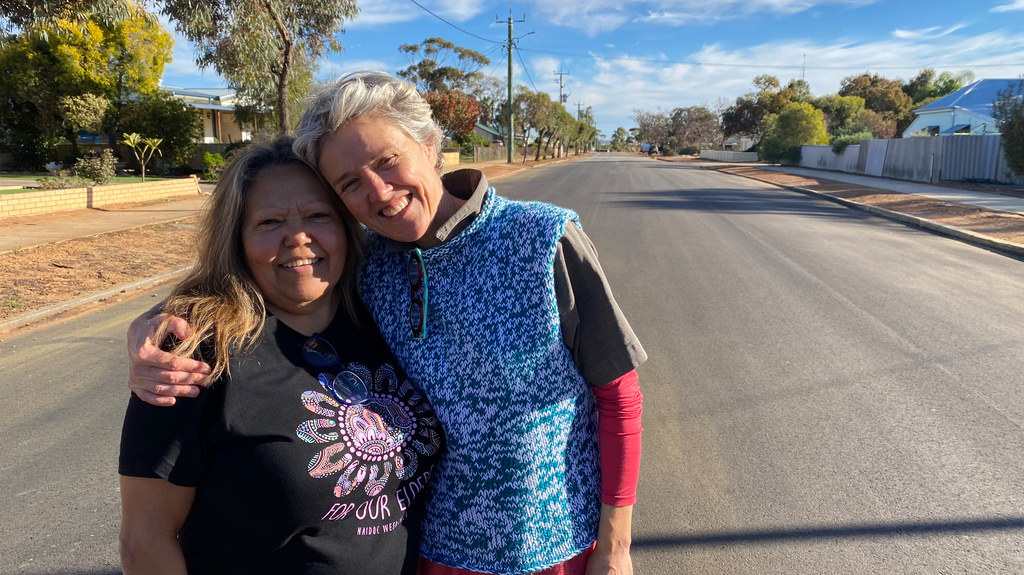
Aunty Tracey de Grussa and Biosphere Boodja Creative Director Fleur Schell in the WA wheatbelt town of Goomalling
About Vanessa Gould
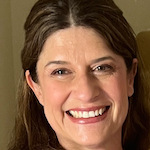 Vanessa Gould is a freelance writer who worked as a journalist on metropolitan newspapers in Western Australia and Hong Kong, later working in public affairs for the British Government and then in corporate communications in Perth, Western Australia, where she is based. Her return to features writing about the arts is a reminder that her favourite people on newspapers were always the photographers and graphic artists. In retrospect, this should have told her something. She is currently the volunteer communications manager for the Biosphere Boodja Arts and Wild Things Festival, where Fleur Schell is creative director.
Vanessa Gould is a freelance writer who worked as a journalist on metropolitan newspapers in Western Australia and Hong Kong, later working in public affairs for the British Government and then in corporate communications in Perth, Western Australia, where she is based. Her return to features writing about the arts is a reminder that her favourite people on newspapers were always the photographers and graphic artists. In retrospect, this should have told her something. She is currently the volunteer communications manager for the Biosphere Boodja Arts and Wild Things Festival, where Fleur Schell is creative director.

